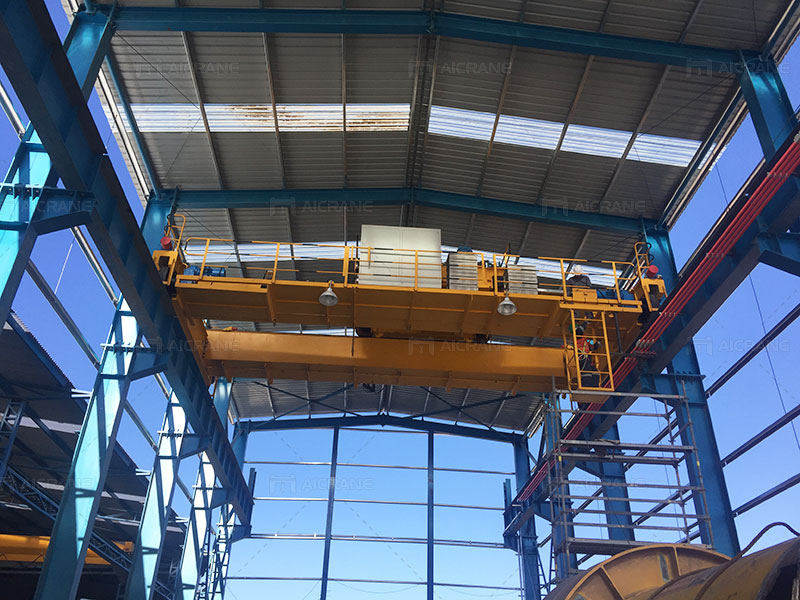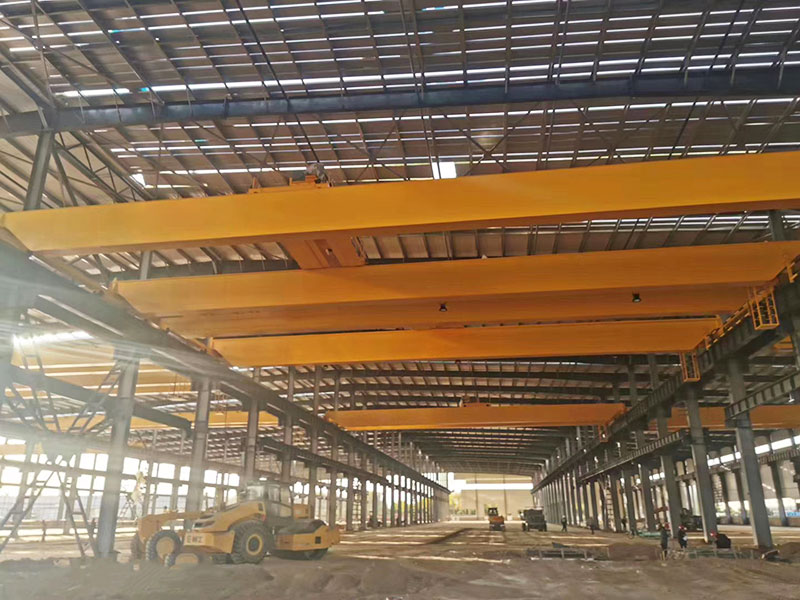50-ton overhead cranes are critical pieces of equipment used in various industries for lifting and transporting heavy loads efficiently and safely. These cranes are indispensable in sectors such as manufacturing, construction, steel production, and power plants. If you’re new to overhead cranes, understanding their components and functions is essential for selecting the right equipment, ensuring safety, and maximizing operational efficiency. This guide provides a comprehensive overview of the key components and their roles in a 50 ton overhead crane.

1. Key Components of a 50-Ton Overhead Crane
Bridge
The bridge is the most prominent component of an overhead crane. It spans the width of the working area and serves as the main structure that supports the hoist and trolley. Bridges can be configured in two primary types:
- Single Girder: Features one main beam; suitable for lighter applications or areas with limited headroom.
- Double Girder: Consists of two parallel beams; ideal for heavy-duty applications, offering higher lifting capacities and stability for 50-ton loads.
Hoist
The hoist is the component responsible for lifting and lowering the load. In a 50-ton crane, hoists are typically powered by electricity and can feature the following mechanisms:
- Electric Wire Rope Hoist: Used for high-capacity lifting with smooth and precise movement.
- Electric Chain Hoist: Less common for heavy-duty cranes, but sometimes used for specific applications.
The hoist is equipped with a lifting motor, gearbox, drum, and brake to ensure reliable operation.
Trolley
The trolley moves along the bridge, carrying the hoist and load horizontally. In 50-ton cranes, trolleys are built for heavy-duty performance, offering smooth travel and high load capacities. They can be classified as:
- Top Running Trolley: Operates on top of the bridge girders, maximizing the available lifting height.
- Under Running Trolley: Suspended below the girders; often used in areas with low headroom.
Runway System
The runway consists of tracks or beams that support the bridge and allow it to move along the length of the work area. Runways are mounted on columns or walls and are designed to bear the weight of the crane and its load.

Control System
Modern 50-ton cranes are equipped with advanced control systems for safe and efficient operation. The control systems can include:
- Pendant Control: Handheld control devices connected to the crane.
- Wireless Remote Control: Allows operators to control the crane from a remote distance.
- Cabin Control: Enclosed operator cabins, ideal for high-precision or long-duration operations.
End Trucks
End trucks are located at either end of the bridge and house the wheels that enable the crane to travel along the runway. They are critical for ensuring smooth and stable movement of the crane across the workspace.
Electrical Systems
The electrical systems provide power to the hoist, trolley, and bridge. Key electrical components include:
- Motors: Provide the necessary power for lifting, trolley travel, and bridge movement.
- Control Panels: Manage power distribution and enable precise control of crane operations.
- Cables and Festoon Systems: Ensure uninterrupted power and signal transmission across the crane.
Safety Features
Safety is paramount in operating a 50-ton overhead crane. Essential safety components include:
- Overload Protection: Prevents the crane from lifting loads beyond its capacity.
- Limit Switches: Stop the crane’s motion when it reaches the end of its allowable travel.
- Anti-Sway System: Reduces load swing, enhancing precision and safety.
- Emergency Stop Systems: Allow operators to halt operations instantly in case of an emergency.
2. Functions of a 50-Ton Overhead Crane
The 50-ton overhead crane performs several vital functions, making it an essential tool for industrial operations. Key functions include:
Lifting Heavy Loads
The primary function of a 50-ton crane is to lift and transport loads weighing up to 50 tons. This capability is essential in industries like steel production, where large metal sheets, coils, or machinery components need to be moved.
Efficient Material Handling
By providing fast and precise load transportation, overhead crane for sale improves workflow efficiency and reduce labor costs. They can move materials horizontally and vertically within a designated area.
Maximizing Space Utilization
Unlike ground-based lifting equipment, overhead cranes operate above the workspace, leaving floor space free for other operations. This is particularly beneficial in crowded industrial facilities.
Enhancing Safety
With advanced safety features, overhead cranes minimize risks associated with manual lifting and reduce workplace injuries. Automated and remote-controlled systems further enhance safety by distancing operators from hazardous areas.
Supporting Custom Applications
Overhead cranes can be customized to meet specific operational requirements. For example, a 50-ton crane used in a power plant may have additional features like heat-resistant components or a larger lifting height.
3. Selecting the Right 50-Ton Overhead Crane
When choosing a 50-ton overhead crane, consider the following factors:
- Application: Determine the type of materials and operations the crane will handle.
- Work Environment: Consider factors like headroom, runway length, and environmental conditions.
- Customization: Assess whether additional features, such as anti-sway systems or specialized hooks, are required.
- Supplier Reliability: Choose a reputable supplier who provides high-quality products, installation support, and after-sales service.
4. Maintenance and Inspection
Regular maintenance and inspections are essential for the safe and efficient operation of a 50-ton overhead crane. Key maintenance practices include:
- Lubricating moving parts to prevent wear and tear.
- Checking electrical systems for faults or damage.
- Inspecting hoist ropes and chains for signs of fatigue.
- Ensuring all safety features, such as limit switches, are functioning properly.
Conclusion
Understanding the components and functions of a 50-ton overhead crane is the first step toward utilizing this powerful lifting equipment effectively. By familiarizing yourself with its key parts and their roles, you can ensure optimal performance, improve workplace safety, and make informed decisions when purchasing or operating such cranes. Whether lifting heavy steel coils, assembling massive machinery, or streamlining logistics, a 50-ton overhead crane is an invaluable tool for heavy-duty industrial operations.
